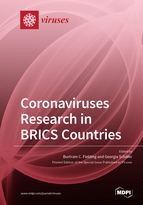Coronaviruses Research in BRICS Countries
A special issue of Viruses (ISSN 1999-4915). This special issue belongs to the section "SARS-CoV-2 and COVID-19".
Deadline for manuscript submissions: closed (21 December 2021) | Viewed by 48744
Special Issue Editors
Interests: human coronaviruses; SARS-CoV; HCoV-NL63; MERS-CoV; SARS-CoV-2; molecular and cell biology
Special Issues, Collections and Topics in MDPI journals
Interests: oncogenic and emerging viruses; KSHV; EBV; HPV; SARS-CoV-2; HIV
Special Issues, Collections and Topics in MDPI journals
Special Issue Information
Dear colleagues,
SARS-CoV-2 has infected more than 105 million people worldwide. During this pandemic, researchers and clinicians have been working to understand the molecular mechanisms that underpin viral pathogenesis by studying viral–host interactions. Now with the global rollout of various COVID-19 vaccines—based on the neutralization of the spike protein using different technologies—viral immunology and cell-based immunity are being investigated. Researchers are also studying how various SARS-CoV-2 genetic mutations will impact the efficacy of these COVID-19 vaccines. At the same time, various antiviral drugs have been identified or repurposed that have potential as an anti-SARS-CoV-2 treatment.
BRICS (Brazil, Russia, India, China, and South Africa) is the acronym used to associate five major emerging national economies. The BRICS countries are known for their significant influence on regional affairs, including being leaders in scientific and clinical research and innovation. This Special Issue is open to all researchers from BRICS countries, in particular South Africa, involved in the study of SARS-CoV-2 and COVID-19. Original articles, as well as new perspectives or reviews on the matter, are welcome. Research in the fields of vaccine studies, pathogenesis, genetic mutations, viral immunology, and antiviral drugs are especially encouraged.
Prof. Dr. Burtram C. Fielding
Dr. Georgia Schäfer
Guest Editors
Manuscript Submission Information
Manuscripts should be submitted online at www.mdpi.com by registering and logging in to this website. Once you are registered, click here to go to the submission form. Manuscripts can be submitted until the deadline. All submissions that pass pre-check are peer-reviewed. Accepted papers will be published continuously in the journal (as soon as accepted) and will be listed together on the special issue website. Research articles, review articles as well as short communications are invited. For planned papers, a title and short abstract (about 100 words) can be sent to the Editorial Office for announcement on this website.
Submitted manuscripts should not have been published previously, nor be under consideration for publication elsewhere (except conference proceedings papers). All manuscripts are thoroughly refereed through a single-blind peer-review process. A guide for authors and other relevant information for submission of manuscripts is available on the Instructions for Authors page. Viruses is an international peer-reviewed open access monthly journal published by MDPI.
Please visit the Instructions for Authors page before submitting a manuscript. The Article Processing Charge (APC) for publication in this open access journal is 2600 CHF (Swiss Francs). Submitted papers should be well formatted and use good English. Authors may use MDPI's English editing service prior to publication or during author revisions.
Keywords
- SARS-CoV-2
- COVID-19
- viral pathogenesis
- vaccines
- antivirals
- viral-host interactions
- viral immunology
- cell-based immunity
- genetic mutations
- drug repurposing








